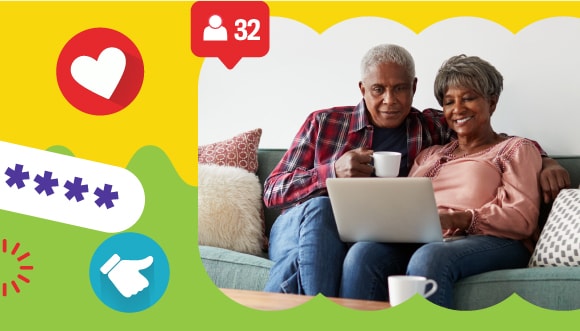At Get Cyber Safe, our goal is to make cyber security easy and simple for all Canadians. We believe that with the right advice and guidance, anyone can take control of their cyber safety. This blog post may be especially useful for older adults, who we define as Canadians over the age of 50, but we believe that the information could help anyone at any age, in any stage in their cyber security journey.
 Social media enables us to share things like information and our interests and ideas with our friends and families. Navigating social media is not always easy, but that does not mean older adults should avoid using it. If you protect yourself and your accounts from common cyber threats, then you are ready to enjoy all the positives that social media can offer!
Social media enables us to share things like information and our interests and ideas with our friends and families. Navigating social media is not always easy, but that does not mean older adults should avoid using it. If you protect yourself and your accounts from common cyber threats, then you are ready to enjoy all the positives that social media can offer!
Protect yourself with a strong password
A strong password is the first step in protecting your account from cyber attacks. The stronger your password is, the more protected you will be. A key thing to remember is never reuse the same password for more than one account, whether that it your email, online banking or social media accounts. But remembering all those passwords isn’t always easy. Try storing all your unique passwords in a password manager. There are many options, so make sure to choose the best password manager for you to help protect you from potential cyber attacks.
Enable multi-factor authentication
Multi-factor authentication is an important cyber security measure because it provides an added layer of security for devices, accounts, and information. The most common form of multi-factor authentication is called two-step verification. This can happen when your login credentials, meaning your username and password, are paired with another way to identify you, known as an authentication factor. This could be–a text message sent to your phone or an email sent to your inbox that you have to reply to. This two-step verification is better than a password alone. But what’s best is using a different type of second authentication factor that is not on a digital device: something you have (e.g. a token, smartcard) or something you own (e.g. a biometric like a fingerprint).
On social media, for example, the verification chain might go like this:
- To gain access to your social media account, you type in your password.
- To make changes to that account, you are asked to scan your fingerprint.
This ensures that a cyber criminal can’t make big changes to the account, such as changing the email address for password recovery.
Keep your personal information private
Social media is often used as a space to share content and to stay connected with loved ones. For your social media to be a safe space, it’s important for your privacy settings to be well managed. Make sure to keep your personal information private to reduce the risks of your account being compromised. Here are some tips to secure your account:
- Under account settings, et your account to private, to only interact and share photos with the followers you’ve accepted, such as family and friends.
- Spot the signs of cyber threats and do not click on links in posts or direct messages unless you can confirm it is a legitimate source.
- Confirm through another media source that your contacts are who they say they are if you experience suspicious behaviour.
- Report suspicious behaviour to the support team on the platform.
Beware of suspicious behaviour
When it comes to accepting friend requests on social media, make sure that you know the person sending you a request. Cyber criminals use phishing tactics to try to befriend you by posing as someone you know. Always verify someone is who they say they are by connecting with them on a verified alternate platform. Be aware of the signs of phishing and be cautious of unsolicited messages you receive and random offers that seem too good to be true (they often are too good to be true). Strange or unusual messages coming from an account you are familiar with could mean they have been hacked. If you receive a suspicious friend request or message, connect with that person on another platform or ignore and delete the request.
Share information cautiously
As social media continues to grow, so does the risk of cyber attacks. It is important to avoid sharing too much information online. The more information about yourself that you share online, the more you allow others, including cyber criminals, to learn about you. Never share any sensitive information on social media like banking information, SIN numbers, addresses, phones numbers or passwords. Cyber criminals can use your sensitive information for their social engineered phishing tactics.
Conclusion
Take your cyber security into consideration before posting and engaging with others online. Navigating social media is not always easy, but with these tips you are ready to take on the social networking world and get cyber safe!